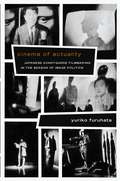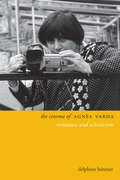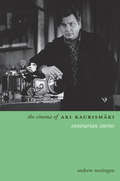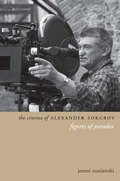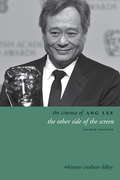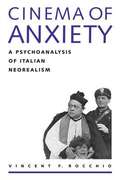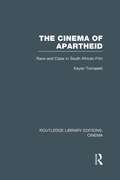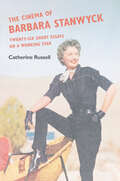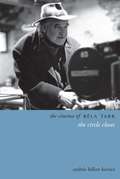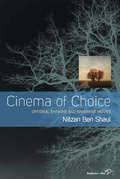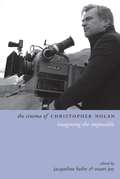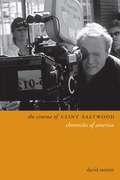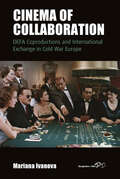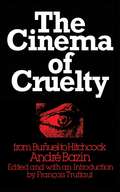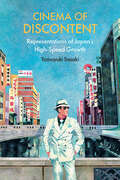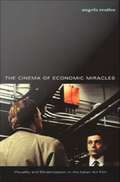- Table View
- List View
Cinema of Actuality: Japanese Avant-Garde Filmmaking in the Season of Image Politics
by Yuriko FuruhataDuring the 1960s and early 1970s, Japanese avant-garde filmmakers intensely explored the shifting role of the image in political activism and media events. Known as the "season of politics," the era was filled with widely covered dramatic events from hijackings and hostage crises to student protests. This season of politics was, Yuriko Furuhata argues, the season of image politics. Well-known directors, including Oshima Nagisa, Matsumoto Toshio, Wakamatsu Kōji, and Adachi Masao, appropriated the sensationalized media coverage of current events, turning news stories into material for timely critique and intermedial experimentation. Cinema of Actuality analyzes Japanese avant-garde filmmakers' struggle to radicalize cinema in light of the intensifying politics of spectacle and a rapidly changing media environment, one that was increasingly dominated by television. Furuhata demonstrates how avant-garde filmmaking intersected with media history, and how sophisticated debates about film theory emerged out of dialogues with photography, television, and other visual arts.
The Cinema of Agnès Varda: Resistance and Eclecticism (Directors' Cuts)
by Delphine BenezetAgnès Varda, a pioneer of the French New Wave, has been making radical films for over half a century. Many of these are considered by scholars, filmmakers, and audiences alike, as audacious, seminal, and unforgettable. This volume considers her production as a whole, revisiting overlooked films like Mur, Murs/Documenteur (1980–81), and connecting her cinema to recent installation work. This study demonstrates how Varda has resisted norms of representation and diktats of production. It also shows how she has elaborated a personal repertoire of images, characters, and settings, which all provide insight on their cultural and political contexts. The book thus offers new readings of this director's multifaceted rêveries, arguing that her work should be seen as an aesthetically influential and ethically-driven production where cinema is both a political and collaborative practice, and a synesthetic art form.
The Cinema of Agnès Varda
by Delphine BenezetAgnès Varda, a pioneer of the French New Wave, has been making radical films for over half a century. Many of these are considered by scholars, filmmakers, and audiences alike, as audacious, seminal, and unforgettable. This volme considers her production as a whole, revisiting overlooked films like Mur, Murs/Documenteur (1980--81), and connecting her cinema to recent installation work. This study demonstrates how Varda has resisted norms of representation and diktats of production. It also shows how she has elaborated a personal repertoire of images, characters, and settings, which all provide insight on their cultural and political contexts. The book thus offers new readings of this director's multifaceted rêveries, arguing that her work should be seen as an aesthetically influential and ethically-driven production where cinema is both a political and collaborative practice, and a synesthetic art form.
The Cinema of Aki Kaurismäki: Contrarian Stories (Directors' Cuts)
by Andrew NestingenAki Kaurismäki is an enigma, an eminent auteur who claims his films are a joke. Since 1983, Kaurismäki has produced classically-styled films filled with cinephilic references to film history. He has earned an international art-house audience and many prizes, influencing such directors as Jim Jarmusch, Quentin Tarantino, and Wes Anderson. Yet Kaurismäki is often depicted as the loneliest, most nostalgic of Finns (except when he promotes his films, makes political statements, and runs his many businesses). He is also depicted as a bohemian known for outlandish actions and statements. The Cinema of Aki Kaurismäki is the first comprehensive English-language study of this eccentric director. Drawing on revisionist approaches to film authorship, the text links the filmmaker and his films to the stories and issues animating film aesthetics and history, nostalgia, late modernity, politics, commerce, film festivals, and national cinema.
The Cinema of Aki Kaurismäki: Contrarian Stories
by Andrew NestingenAki Kaurismäki is an enigma, an eminent auteur who claims his films are a joke. Since 1983, Kaurismäki has produced classically-styled films filled with cinephilic references to film history. He has earned an international art-house audience and many prizes, influencing such directors as Jim Jarmusch, Quentin Tarantino, and Wes Anderson. Yet Kaurismäki is often depicted as the loneliest, most nostalgic of Finns (except when he promotes his films, makes political statements, and runs his many businesses). He is also depicted as a bohemian known for outlandish actions and statements. The Cinema of Aki Kaurismäki is the first comprehensive English-language study of this eccentric director. Drawing on revisionist approaches to film authorship, the text links the filmmaker and his films to the stories and issues animating film aesthetics and history, nostalgia, late modernity, politics, commerce, film festivals, and national cinema.
The Cinema of Alexander Sokurov: Figures of Paradox (Directors' Cuts)
by Jeremi SzaniawskiOne of the last representatives of a brand of serious, high-art cinema, Alexander Sokurov has produced a massive oeuvre exploring issues such as history, power, memory, kinship, death, the human soul, and the responsibility of the artist. Through contextualization and close readings of each of his feature fiction films (broaching many of his documentaries in the process), this volume unearths a vision of Sokurov's films as equally mournful and passionate, intellectual, and sensual, and also identifies in them a powerful, if discursively repressed, queer sensitivity, alongside a pattern of tensions and paradoxes. This book thus offers new keys to understand the lasting and ever-renewed appeal of the Russian director's Janus-like and surprisingly dynamic cinema – a deeply original and complex body of work in dialogue with the past, the present and the future.
The Cinema of Alexander Sokurov: Figures of Paradox
by Jeremi SzaniawskiOne of the last representatives of a brand of serious, high-art cinema, Alexander Sokurov has produced a massive oeuvre exploring issues such as history, power, memory, kinship, death, the human soul, and the responsibility of the artist. Through contextualization and close readings of each of his feature fiction films (broaching many of his documentaries in the process), this volume unearths a vision of Sokurov's films as equally mournful and passionate, intellectual, and sensual, and also identifies in them a powerful, if discursively repressed, queer sensitivity, alongside a pattern of tensions and paradoxes. This book thus offers new keys to understand the lasting and ever-renewed appeal of the Russian director's Janus-like and surprisingly dynamic cinema -- a deeply original and complex body of work in dialogue with the past, the present and the future.
The Cinema of Ang Lee: The Other Side of the Screen, second edition
by Dilley Whitney CrothersSuggestive readings of gender and identity explore the international appeal of Ang Lee
The Cinema of Ang Lee: The Other Side of the Screen (Directors' Cuts)
by Whitney Crothers DilleyBorn in Taiwan, Ang Lee is one of cinema's most versatile and daring directors. His ability to cut across cultural, national, and sexual boundaries has given him recognition in all corners of the world, the ability to work with complete artistic freedom whether inside or outside of Hollywood, and two Academy Awards for Best Director. He has won astounding critical acclaim for Crouching Tiger, Hidden Dragon (2000), which transformed the status of martial arts films across the globe, Brokeback Mountain (2005), which challenged the reception and presentation of homosexuality in mainstream cinema, and Life of Pi (2012), Lee's first use of groundbreaking 3D technology and his first foray into complex spiritual themes.In this volume, the only full-length study of Lee's work, Whitney Crothers Dilley analyzes all of his career to date: Lee's early Chinese trilogy films (including The Wedding Banquet, 1993, and Eat Drink Man Woman, 1994), period drama (Sense and Sensibility, 1995), martial arts (Crouching Tiger, Hidden Dragon, 2000), blockbusters (Hulk, 2003), and intimate portraits of wartime psychology, from the Confederate side of the Civil War (Ride with the Devil, 1999) to Japanese-occupied Shanghai (Lust/Caution, 2007). Dilley examines Lee's favored themes such as father/son relationships and intergenerational conflict in The Ice Storm (1997) and Taking Woodstock (2009). By looking at the beginnings of Lee's career, Dilley positions the filmmaker's work within the roots of the Taiwan New Cinema movement, as well as the larger context of world cinema. Using suggestive readings of both gender and identity, this new study not only provides a valuable academic resource but also an enjoyable read that uncovers the enormous appeal of this acclaimed director.
The Cinema of Ang Lee
by Whitney Crothers DilleySuggestive readings of gender and identity explore the international appeal of Ang Lee
The Cinema of Ang Lee
by Whitney Crothers DilleySuggestive readings of gender and identity explore the international appeal of Ang Lee
Cinema of Anxiety: A Psychoanalysis of Italian Neorealism
by Rocchio Vincent F.Rocchio builds his analysis around case studies of the films Rome: Open City, Bicycle Thieves, La Terra Trema, Bitter Rice, and Senso. Through the lens of psychoanalysis, he challenges the traditional understanding of Neorealism as a progressive cinema and instead reveals the anxieties it encodes: a society in political turmoil, an economic system in collapse, and a national cinema in ruins; while war, occupation, collaboration, and retaliation remain a part of everyday life.
The Cinema of Apartheid: Race and Class in South African Film (Routledge Library Editions: Cinema)
by Keyan TomaselliThis study analyses the historical development of South African cinema up to he book's original publication in 1988. It describes the films and comments on their relationship to South African realities, addressing all aspects of the industry, focusing on domestic production, but also discussing international film companies who use South Africa as a location. It explores tensions between English-language and Afrikaans-language films, and between films made for blacks and films made for whites. Going behind the scenes the author looks at the financial infrastructure, the marketing strategies, and the works habits of the film industry. He concludes with a discussion of independent filmmaking, the obstacles facing South Africans who want to make films with artistic and political integrity, and the possibilities of progress in the future. Includes comprehensive bibliography and filmography listing all feature films made in South Africa between 1910 and 1985 together with documentary films by South Africans, non-South Africans, and exiles about the country.
The Cinema of Barbara Stanwyck: Twenty-Six Short Essays on a Working Star (Women’s Media History Now!)
by Catherine RussellFrom The Lady Eve, to The Big Valley, Barbara Stanwyck played parts that showcased her multidimensional talents but also illustrated the limits imposed on women in film and television. Catherine Russell’s A to Z consideration of the iconic actress analyzes twenty-six facets of Stanwyck and the America of her times. Russell examines Stanwyck’s work onscreen against the backdrop of costuming and other aspects of filmmaking. But she also views the actress’s off-screen performance within the Hollywood networks that made her an industry favorite and longtime cornerstone of the entertainment community. Russell’s montage approach coalesces into an engrossing portrait of a singular artist whose intelligence and savvy placed her center-stage in the production of her films and in the debates around women, femininity, and motherhood that roiled mid-century America. Original and rich, The Cinema of Barbara Stanwyck is an essential and entertaining reexamination of an enduring Hollywood star.
The Cinema of Béla Tarr: The Circle Closes (Directors' Cuts)
by András KovácsThe Cinema of Béla Tarr is a critical analysis of the work of Hungary's most prominent and internationally best known film director, written by a scholar who has followed Bela Tarr's career through a close personal and professional relationship for more than twenty-five years. András Bálint Kovács traces the development of Tarr's themes, characters, and style, showing that almost all of his major stylistic and narrative innovations were already present in his early films and that through a conscious and meticulous recombination of and experimentation with these elements, Tarr arrived at his unique style. The significance of these films is that, beyond their aesthetic and historical value, they provide the most powerful vision of an entire region and its historical situation. Tarr's films express, in their universalistic language, the shared feelings of millions of Eastern Europeans.
The Cinema of Béla Tarr: The Circle Closes
by András Bálint KovácsThe Cinema of Béla Tarr is a critical analysis of the work of Hungary's most prominent and internationally best known film director,
Cinema of Choice
by Nitzan Ben ShaulStandard Hollywood narrative movies prescribe linear narratives that cue the viewer to expect predictable outcomes and adopt a closed state of mind. There are, however, a small number of movies that, through the presentation of alternate narrative paths, open the mind to thoughts of choice and possibility. Through the study of several key movies for which this concept is central, such as Sliding Doors, Run Lola Run, Inglourious Basterds, and Rashomon, Nitzan Ben Shaul examines the causes and implications of optional thinking and how these movies allow for more open and creative possibilities. This book examines the methods by which standard narrative movies close down thinking processes and deliver easy pleasures to the viewer whilst demonstrating that this is not the only possibility and that optional thinking can be both stimulating and rewarding.
The Cinema of Christopher Nolan
by Jacqueline Furby Stuart JoyOver the past fifteen years, writer, producer and director Christopher Nolan has emerged from the margins of independent British cinema to become one of the most commercially successful directors in Hollywood. From Following (1998) to Interstellar (2014), Nolan's films have explored the philosophical concerns of cinema articulated through a distinctive cerebral style that is marked by a frequent experimentation with non-linear storytelling, and yet remains integrated within classical Hollywood narrative and genre frameworks. Through the contextualization and close readings of each of his films, this collection brings together academic work from a range of disciplines to examine the director's central themes and preoccupations -- memory, time, trauma, masculinity and identity -- whilst also offering analyses of otherwise marginalized aspects of his work, such as the function of music, video games and the impact of IMAX and other new technologies.
The Cinema of Christopher Nolan: Imagining the Impossible (Directors' Cuts)
by Furby Jacqueline Joy StuartOver the past fifteen years, writer, producer and director Christopher Nolan has emerged from the margins of independent British cinema to become one of the most commercially successful directors in Hollywood. From Following (1998) to Interstellar (2014), Christopher Nolan's films explore philosophical concerns by experimenting with nonlinear storytelling while also working within classical Hollywood narrative and genre frameworks. Contextualizing and closely reading each of his films, this collection examines the director's play with memory, time, trauma, masculinity, and identity, and considers the function of music and video games and the effect of IMAX on his work.
The Cinema of Clint Eastwood: Chronicles of America (Directors' Cuts)
by David SterrittHe became a movie star playing The Man With No Name, and today his name is known around the world. Measured by longevity, productivity, and profits, Clint Eastwood is the most successful actor-director-producer in American film history. This book examines the major elements of his career, focusing primarily on his work as a director but also exploring the evolution of his acting style, his long association with screen violence, his interest in jazz, and the political views – sometimes hotly controversial – reflected in his films and public statements. Especially fascinating is the pivotal question that divides critics and moviegoers to this day: is Eastwood a capable director with a photogenic face, a modest acting talent, and a flair for marketing his image? Or is he a true cinematic auteur with a distinctive vision of America's history, traditions, and values? From A Fistful of Dollars and Dirty Harry to Million Dollar Baby and beyond, The Cinema of Clint Eastwood takes a close-up look at one of the screen's most influential and charismatic stars.
The Cinema of Clint Eastwood
by David SterrittHe became a movie star playing The Man With No Name, and today his name is known around the world. Measured by longevity, productivity, and profits, Clint Eastwood is the most successful actor-director-producer in American film history. This book examines the major elements of his career, focusing primarily on his work as a director but also exploring the evolution of his acting style, his long association with screen violence, his interest in jazz, and the political views - sometimes hotly controversial - reflected in his films and public statements. Especially fascinating is the pivotal question that divides critics and moviegoers to this day: is Eastwood a capable director with a photogenic face, a modest acting talent, and a flair for marketing his image? Or is he a true cinematic auteur with a distinctive vision of America's history, traditions, and values? From A Fistful of Dollars and Dirty Harry to Million Dollar Baby and beyond, The Cinema of Clint Eastwood takes a close-up look at one of the screen's most influential and charismatic stars.
Cinema of Collaboration: DEFA Coproductions and International Exchange in Cold War Europe (Film Europa #21)
by Mariana IvanovaFrom their very inception, European cinemas undertook collaborative ventures in an attempt to cultivate a transnational “Film-Europe.” In the postwar era, it was DEFA, the state cinema of East Germany, that emerged as a key site for cooperative practices. Despite the significant challenges that the Cold War created for collaboration, DEFA sought international prestige through various initiatives. These ranged from film exchange in occupied Germany to partnerships with Western producers, and from coproductions with Eastern European studios to strategies for film co-authorship. Uniquely positioned between East and West, DEFA proved a crucial mediator among European cinemas during a period of profound political division.
The Cinema of Cruelty: From Buñuel to Hitchcock
by André Bazin François TruffautPerhaps the single most important voice of cinema in the twentieth century, André Bazin profoundly influenced the development of the scholarship that we know now as film criticism. Bazin has acutely analyzed the cinematic values of our time, extending to his international audiences "the impact of art for the understanding and discrimination of his readers."The depth and logic of his commentary has elevated film criticism to new heights. The reputation of André Bazin continues to grow as his writings are published and studied by filmmakers and filmgoers alike. Often referred to as the Edmund Wilson of film, Bazin was more than a critic. "He made me see certain aspects of my work that I was unaware of," said Luis Buñuel. "He was our conscience," wrote Jean Renoir. "He was a logician in action," echoed François Truffaut.In The Cinema of Cruelty, François Truffaut, one of France's most celebrated and versatile filmmakers, has collected Bazin's writings on six film "greats": Erich von Stroheim, Carl Dreyer, Preston Sturges, Luis Buñuel, Alfred Hitchcock, and Akira Kurosawa. The result is a major collection of film criticism.
Cinema of Discontent: Representations of Japan's High-Speed Growth (SUNY series, Horizons of Cinema)
by Tomoyuki SasakiFrom the mid-1950s to the mid-1970s, Japan experienced an unprecedented level of economic growth, transforming itself from a war-devastated country to a global economic power. Our image of postwar Japan has been shaped by this event, and we tend to see its history as a story of great national success. Cinema of Discontent challenges this view and details the tensions generated by massive and intense capitalist development through analyses of popular cinema produced during the era of high-speed growth. The films discussed in this book, directed by Kawashima Yūzō, Masumura Yasuzō, Inoue Akira, Ezaki Mio, and Kumashiro Tatsumi, attracted broad audiences yet remain understudied. Cinema of Discontent contextualizes these films in relation to the politics, economy, intellectual discourse, and cultural texts of the time. By doing so, it demonstrates how these films address problems immanent to Japan's postwar capitalism, including uneven development, increasing corporate control over individuals, precarious and contingent work, and militarized peace and prosperity.
The Cinema of Economic Miracles: Visuality and Modernization in the Italian Art Film
by Angelo RestivoThe Italian art cinema of the 1960s is known worldwide for its brilliance and vitality. Yet rarely has this cinema been considered in relation to the profound economic and cultural changes that transformed Italy during the sixties--described as the "economic miracle. " Angelo Restivo argues for a completely new understanding of that cinema as a negotiation between a national aesthetic tradition of realism and a nascent postmodern image culture. Restivo studies numerous films of the period, focusing mainly on the works of Pier Paolo Pasolini and Michelangelo Antonioni. He finds that these auteurs' films reworked the neorealist aesthetic developed in the 1940s and 1950s, explored issues brought to the fore by the subsequent consumer boom, and presaged developments central to both critical theory and the visual arts in the 1980s and 1990s. Drawing on the theories of Lacan, Zizek, Benjamin, Foucault, Jameson, and Deleuze, he shines new light on such films as Pasolini's Accattone and Teorema, and Antonioni's Red Desert and Blow-Up. Restivo's model for understanding the relationship of the 1960s Italian art film to its cultural contexts also has implications that extend to the developing national cinemas of countries such as Brazil and Taiwan. The Cinema of Economic Miracles will interest scholars and students in all areas of film studies, especially those studying theories of the image, national cinema theory, and Italian cinema, and to those engaged in poststructuralist theory, philosophy, and comparative literature.
